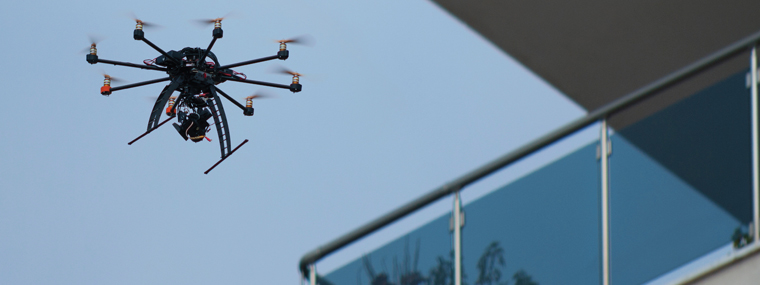
The Legalities of Drones
How Condominiums and Homeowners Associations Can Protect Residents from Disturbances, Nuisances, and Invasions of Privacy
By David B. Haber & Garrett Nemeroff / Published Jul 2015

How would you like a drone flying next to your window 30 floors up in a high-rise condominium staring into your unit, or next to your house while your family is at the pool, taking photos and videos of you and your family and invading your privacy? What can be done about this, and how is the government addressing these concerns?
Drone users today can be grouped into either of two categories. First, there are commercial users, like Amazon, which hopes to eventually use drones to deliver packages directly to consumers. Commercial drones generally do not create any immediate issues for condominium or homeowners associations (HOAs), since commercial drones are currently prohibited by the Federal Aviation Agency (FAA), unless a specific exemption is applied for and obtained. These restrictive regulations, and the FAA’s proposed new regulations, which make it no easier for companies like Amazon to launch their commercial drone operations in the United States, place many of the legal issues involved in commercial drone use at least a few years down the road.
Then there are recreational drone users, or hobbyists, who fly drones to take photographs or videos for their own personal use and enjoyment. While both types of drone uses present complex legal issues for condominiums and HOAs, the use of recreational drones raises many issues, which condominiums and HOAs should begin addressing today.
David B. Haber, Founding Partner
Haber Slade
David B. Haber is the founding partner of Haber Slade. He is a commercial litigator with 29 years of experience who has handled multiple, complex commercial disputes throughout Florida, including condominium and homeowner’s association disputes. Haber can be reached at dhaber@dhaberlaw.com.
Garrett Nemeroff, Associate Attorney
Haber Slade
Garrett Nemeroff is an associate attorney with the firm and can be reached at gnemeroff@dhaberlaw.com. The firm is on the Internet at www.dhaberlaw.com. It concentrates in the practice areas of condominium and HOA law, real estate litigation, construction litigation, aviation law and litigation, complex commercial litigation, and creditors’ rights and bankruptcy.
Recreational drone use currently comes with minimal regulatory resistance from the government. Because of the historically good safety record of model airplanes, when Congress passed the FAA Modernization and Reform Act in 2012, it exempted hobbyists from drone regulations. As a result, the only real limitation on recreational drone use is that the drone must remain within the visual line of sight of its operator and may not fly higher than 400 feet above the ground. The problem, of course, is that drones are not model airplanes. Drones, for example, have multiple rotor capabilities, giving them much more flexibility in the air. Drones are also usually equipped with cameras, giving their users unfettered viewing access to private areas that would otherwise not be accessible, and creating a legion of privacy concerns.
Drones and Privacy Issues
And make no mistake about it, drone users are taking advantage of these new heights. Private hobbyist drone users can seriously impact the privacy rights of others in condominiums and HOAs. Imagine your neighbor’s drone hovering above or adjacent to your property or taking photos or videos through your windows or of your pool area, or condominium owners having drones peeping through their balcony sliding glass doors. There is no denying that associations should begin addressing these privacy issues in order to protect their residents. But realistically, what can be done to protect residents from the mischief of recreational drones?
The answer starts with an understanding that unit owners within condominium or homeowners associations purchase their property subject to the restrictions contained in the association’s governing documents. Because owners purchase their units knowing of the restrictions and covenants contained in these documents, these restrictions are binding on the unit owners so long as they are not wholly arbitrary and do not violate public policy or constitutional rights. An association also has the power, through its board of directors, to promulgate reasonable rules and regulations governing the use of common elements and recreational facilities. Using its rule-making authority, therefore, associations can adopt reasonable rules governing the use of recreational drones by unit owners and residents, as well as the use of drones in or on the common areas of the condominium property.
But the real issue is just how far these regulations can go. For instance, it is possible that a court would find a total ban on drone use unreasonable, at least without some prior determination that the drone is causing, or is likely to cause, a disturbance or nuisance to other residents. Moreover, drone use by non-residents, which takes place off of the condominium property (such as on a public street next to the condominium building), may not be subject to the association’s rules at all. In these situations, the association may be left with no option to protect its residents other than reporting the drone user to local authorities or the FAA. Some arguments that the association may raise in this situation is that the drone user is trespassing on association property by passing over its airspace or harassing residents by peeping into their windows.
Unit Owners And Their Drones
Another important issue is whether the association can regulate drone use by residents, which takes place en-tirely within the resident’s unit. For example, what are the association’s options when a unit owner flies a drone from his own balcony or backyard, but does so in such a way that allows him to see into other units through the drone’s camera? In this situation, arguably no common elements are involved (although, the airspace above the common elements or limited common elements may qualify as association property), and only one or two residents are affected. Ordinarily, associations are hesitant to get involved in purely resident-to-resident disputes. However, the more people affected by the drone, and the more serious a threat the drone becomes to the community as a whole, the more likely it is that the association should, and will, step in and regulate the activity. This is true regardless of whether association property is technically involved.
Then, of course, there are the paparazzi. What rules can the association create to prevent news and tabloid photographers from using drones to get the picture or video that will make the front page of the tabloids and earn the drone user a hefty fee? And once the recreational user realizes that he or she can do the same thing as the paparazzi, what will the impact be as people jockey to make that $50,000 fee for the tabloid picture or video of the week? For now, associations can feel safe knowing that these types of commercial drone uses are more strictly regulated by the FAA. But there is no denying that the right of privacy within condominiums and HOAs is in serious jeopardy.
With so many questions surrounding the legalities of recreational drone use, it is critical for associations to remember that the condominium concept is based on the principle that property owners give up certain freedoms in order to maintain the health, happiness, and peace of mind of the whole community. There must be a balance of everyone’s interests. Thus, when deciding what kinds of regulations to adopt for recreational drone use, associations should consider not only the use rights of individual residents, but also the privacy interests and well-being of the community as a whole. It may well be that this balance requires the association to permit drone use on certain conditions (for example, that the user not create any nuisance, disturbance of other residents’ quiet enjoyment of their homes, or invasion of privacy). But if the association finds that the only real, workable option is a total ban on recreational drone use, then the question becomes—in light of the unique challenges and threats posed by drones—is that decision reasonable, or too restrictive on the rights of residents?



